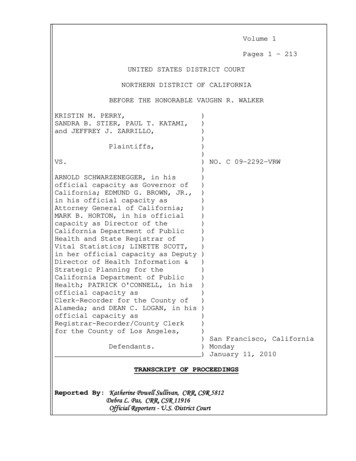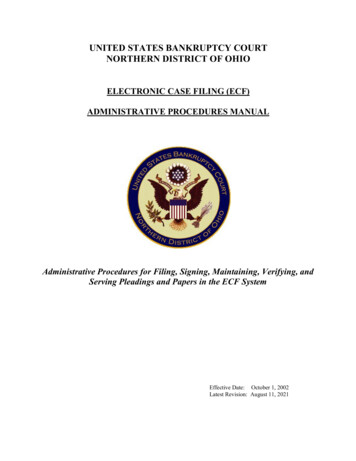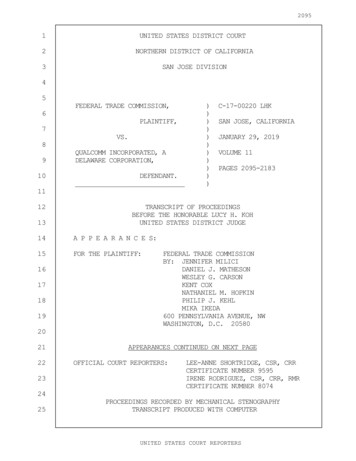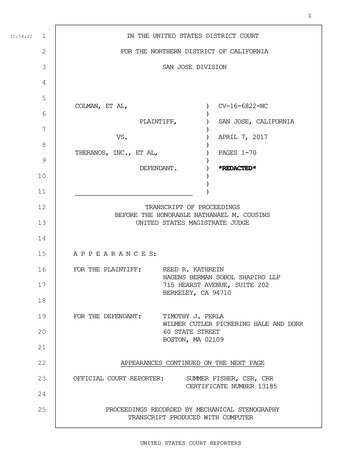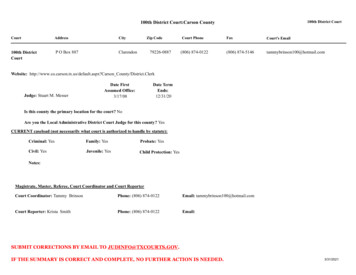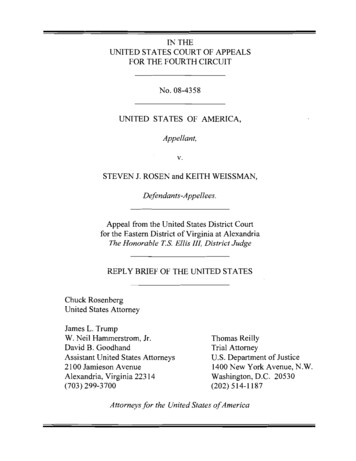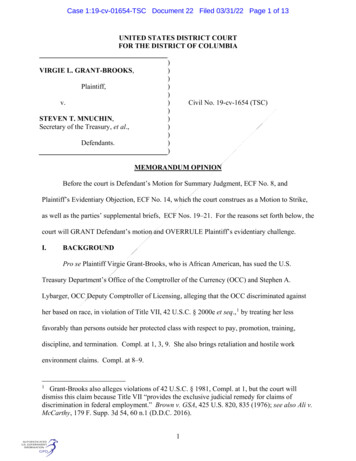
Transcription
Case 1:19-cv-01654-TSC Document 22 Filed 03/31/22 Page 1 of 13UNITED STATES DISTRICT COURTFOR THE DISTRICT OF COLUMBIA))))))))))))VIRGIE L. GRANT-BROOKS,Plaintiff,v.STEVEN T. MNUCHIN,Secretary of the Treasury, et al.,Defendants.Civil No. 19-cv-1654 (TSC)MEMORANDUM OPINIONBefore the court is Defendant’s Motion for Summary Judgment, ECF No. 8, andPlaintiff’s Evidentiary Objection, ECF No. 14, which the court construes as a Motion to Strike,as well as the parties’ supplemental briefs, ECF Nos. 19–21. For the reasons set forth below, thecourt will GRANT Defendant’s motion and OVERRULE Plaintiff’s evidentiary challenge.I.BACKGROUNDPro se Plaintiff Virgie Grant-Brooks, who is African American, has sued the U.S.Treasury Department’s Office of the Comptroller of the Currency (OCC) and Stephen A.Lybarger, OCC Deputy Comptroller of Licensing, alleging that the OCC discriminated againsther based on race, in violation of Title VII, 42 U.S.C. § 2000e et seq., 1 by treating her lessfavorably than persons outside her protected class with respect to pay, promotion, training,discipline, and termination. Compl. at 1, 3, 9. She also brings retaliation and hostile workenvironment claims. Compl. at 8–9.1Grant-Brooks also alleges violations of 42 U.S.C. § 1981, Compl. at 1, but the court willdismiss this claim because Title VII “provides the exclusive judicial remedy for claims ofdiscrimination in federal employment.” Brown v. GSA, 425 U.S. 820, 835 (1976); see also Ali v.McCarthy, 179 F. Supp. 3d 54, 60 n.1 (D.D.C. 2016).1
Case 1:19-cv-01654-TSC Document 22 Filed 03/31/22 Page 2 of 13Plaintiff was employed by the Treasury Department for fifteen years. Prior to 2011 shewas employed in the Office of Thrift Supervision, during which time she claims that she received“the highest possible performance ratings.” Compl. at 4. After Congress enacted the DoddFrank Wall Street Reform Act, however, the agency apparently went through a restructuring thatresulted in the transfer of all Office of Thrift Supervision employees to the OCC, where Plaintiffclaims her duties changed. Defs. Ex. 8 at 14; Compl. at 4, 6. She alleges the OCC assigned herunfamiliar duties and, unlike the manner in which the agency treated similarly situated whitemale employees, the agency disciplined her more harshly and denied her requests for trainingand mentorship. Compl. at 4, 6–7.During her employment, Plaintiff was a member of the National Treasury EmployeesUnion (NTEU) and subject to a collective bargaining agreement (CBA) with the OCC. Compl.at 4; Defs. Statement of Undisputed Facts (“SOF”) ¶ 2. 2 Article 23, Section 5 of Plaintiff’s CBAprovides that “[p]ursuant to 5 USC 7121(d), a complaint involving a claim of discriminationbased upon race, color, religion, gender, national origin, age (40 ), or disability may, at thediscretion of the employee, be raised under either the Employer’s EEO administrative complaintprocess or through the negotiated grievance procedure, but not both.” Defs. Ex. 1 (emphasisadded).2The court warned Plaintiff of the consequences of failing to respond to the OCC’sStatement of Undisputed Facts (SOF). ECF Nos. 13, 18. The court also warned Plaintiffthat she must support her factual allegations with citations to the record. ECF Nos. 13,18. Plaintiff failed to heed either warning in her original opposition brief, ECF No. 14,and in her supplemental opposition, simply reiterated her evidentiary challenge, ECF No.20 at 4. Therefore, the court will treat the OCC’s SOF as conceded, except to the extentPlaintiff’s brief points to portions of the record showing that the asserted fact is disputed.See Local Civil Rule 7(h)(1) (“In determining a motion for summary judgment, the courtmay assume that facts identified by the moving party in its statement of material facts areadmitted, unless such a fact is controverted in the statement of genuine issues filed inopposition to the motion.”).2
Case 1:19-cv-01654-TSC Document 22 Filed 03/31/22 Page 3 of 13On January 15, 2013, Plaintiff elected to pursue the negotiated grievance procedure whenthe NTEU Chapter 302 President filed a “step-one” grievance on Plaintiff’s behalf. Defs. Exs. 1,2. On the grievance form, Plaintiff complained about her December 2012 Performanceevaluation, alleging she was “not provided the same training structure, opportunity or graceperiods afforded similarly situated” employees during the year prior to the evaluation. Defs. Ex.2. Plaintiff alleged a “violation of D-F, OCC Policies and Procedures and Title VII” as the legalbasis for her claims and requested, as a remedy, “Transfer to Dallas Licensing or detail to affordtraining opportunity.” Id.Several months later, on April 4, 2013, Plaintiff received a Notice of Opportunity toImprove Performance, giving her 90 days to correct certain alleged performance deficiencies.SOF ¶ 7; Defs. Ex. 3.The OCC subsequently denied the grievance on July 17, 2013. Defs. Ex. 2. The OCCfound, among other things, that Plaintiff had participated in a three-day training—as had her coworkers—and that beyond such training, performing her assigned duties with the assistance ofany OCC mentors had afforded Plaintiff the best opportunity to become proficient in herposition. Id. at 1–2. The OCC noted that no other former OTS staff had rotated to an outsideoffice for training. Id. at 2. Consequently, OCC concluded that it had treated Plaintiff the sameas similarly situated employees and therefore denied her request to transfer to Dallas or for anassignment to a detail for training. Id. The OCC decision explained that Plaintiff could appealthe decision by filing a “step-two grievance,” with the Deputy Comptroller within ten workingdays after she received the decision, in accordance with Article 27 of her CBA. Id. Two dayslater the NTEU filed a “step-two” grievance on her behalf regarding the 2012 performanceevaluation. Suppl. SOF ¶ 1. The OCC did not issue a response and therefore, under the terms ofher CBA, Plaintiff could proceed to arbitration. Id. ¶ 3.3
Case 1:19-cv-01654-TSC Document 22 Filed 03/31/22 Page 4 of 13Approximately one week later, on July 25, 2013, the OCC issued Plaintiff a Notice ofProposed Removal for unacceptable performance. Defs. Ex. 4. The notice explained thatPlaintiff could respond orally and/or in writing. Id. at 5. Plaintiff elected to respond orally. SOF¶ 9; see Defs. Ex. 6.Plaintiff subsequently contacted the OCC’s Equal Employment Opportunity (EEO)office, on August 5, 2013, for counseling regarding the proposed removal notice, contending,among other things, that the agency’s allegedly discriminatory denial of training and mentoringled to her proposed removal. Defs. Ex. 10.Several months later, on October 7, 2013 the OCC notified Plaintiff that it was removingher from her position for unacceptable job performance. Defs. Ex. 5 at 1. The notice explainedthat she had the right to contest the decision by: 1) appealing to the Merit Systems ProtectionBoard, 2) engaging in arbitration invoked by the NTEU, 3) filing an Equal EmploymentOpportunity complaint, or (4) seeking corrective action with the Office of Special Counsel if shebelieved the proposed removal was in reprisal for whistle-blowing activity. Id. at 2. The noticewarned Plaintiff:You may select only one of these procedures. Your election of a procedure will bedetermined based on the first-received timely filing under one of these procedures.Electing to file under one procedure waives your right to file under the others,except as noted. The instructions for filing an appeal, invoking arbitration, filing acomplaint, or seeking corrective action for whistleblowing activity follow below.Id. (emphasis added). On October 17, 2013, the Union sent a letter on Plaintiff’s behalfto the OCC invoking the arbitration option to challenge the removal. SOF ¶ 12; Defs. Ex.6.4
Case 1:19-cv-01654-TSC Document 22 Filed 03/31/22 Page 5 of 13The following day, Plaintiff began completing a formal EEO complaint, but she did notfile it until several weeks later, on November 2, 2013. 3 See SOF ¶ 24; Defs. Ex. 11. On theEEO complaint form, Plaintiff stated that she first became aware of the alleged discrimination onor around October 1, 2012. Defs. Ex. 11 at 3. She complained of an “ongoing denial ofappropriate training,” as well as the “loss of a 17 year career,” and she requested as remedies“remove adverse ratings; restitution – remuneration of lost wages.” Id. In response to thequestion of whether she had filed a grievance “[o]n this same matter,” Plaintiff checked the boxfor “agency grievance procedure,” and explained that a “specific grievance was filed for 2012performance evaluation rating on the basis that no training was provided.” Id.An arbitration hearing on both the performance evaluation and removal grievances washeld on March 10, 2014. SOF ¶ 12; Defs. Exs. 7, 8; Supp. SOF ¶¶ 4–7; Defs. Ex. 20, Hr’g Tr. at6–7, 42–44, 52–57, 172–175. The parties stipulated that the two issues to be considered werewhether the OCC failed to 1) sufficiently communicate the minimum level of performancerequired to avoid removal, and 2) provide Plaintiff with a reasonable opportunity to improve herperformance. Defs. Ex. 8 at 11; Defs. Ex. 6, Hr’g Tr. at 7–8. During the hearing, Plaintiff alsoargued that the agency failed to provide her with sufficient training to perform her job duties.See Defs. Ex. 7, Hr’g Tr. at 20–21, 226–29. She did not raise any discrimination claims. Supp.SOF ¶ 10; see Defs. Ex. 8.On June 2, 2014, the arbitrator issued a written decision addressing both grievances.Defs. Ex. 8 at 1. The decision included discussion and analysis of: 1) the events leading up tothe 2012 Performance Evaluation, as well as the subsequent grievance; 2) the events leading up3OCC claims Plaintiff filed her EEO complaint on 11-2-13. SOF ¶ 24. The complaint lists“10-18-13” as the “filing date,” but next to that date “11-2-13” appears in the margin. The faxline on the document and the agency’s date stamp also show 11-2-13. In light of this evidenceand Plaintiff’s failure to respond to the OCC’s statement of undisputed facts, the court finds thatthe 11-2-13 date is undisputed.5
Case 1:19-cv-01654-TSC Document 22 Filed 03/31/22 Page 6 of 13to the removal; 3) whether formal training was provided versus on-the job training throughoutPlaintiff’s employment at the OCC; 4) the availability of mentoring; and 5) the two stipulatedissues: sufficiency of the OCC’s communication regarding performance expectations, and theOCC’s alleged failure to provide a reasonable opportunity to improve performance. Defs. Ex. 8.The arbitrator denied the grievance. Id. at 20.Pursuant to Article 28, Section 7 of the CBA, the arbitrator’s decision was considered“final and binding,” but Plaintiff could have filed “an exception” with the Federal RelationsLabor Authority in accordance with OCC regulations. SOF ¶¶ 16–18; Defs. Ex. 1. Plaintiff hadthirty days after the decision service date to file an exception but did not do so. SOF ¶¶ 19–20; 5C.F.R. § 2425.2(b). Instead, she appealed to the Merit Systems Protection Board (MSPB). SOF¶ 21; Defs. Ex. 9.The MSPB denied her appeal, concluding, among other things, that it lacked jurisdictionover her request for review of the arbitration decision because its authority over claims involvingdiscrimination is limited. SOF ¶ 22; Defs. Ex. 9. The MSPB may review decisions involvingdiscrimination claims: 1) if the claimant raised them in connection with a grievance, or 2) if theclaimant is raising them for the first time before the MSPB because they could not have beenraised during the grievance process. Defs. Ex. 9 at 3. During its proceedings, the MSPB issueda Show Cause Order explaining Plaintiff’s jurisdictional burden and directing her to file evidenceand argument on whether she had raised a claim of discrimination with the arbitrator. Defs. Ex.9 at 3-4. After Plaintiff responded that she had not raised the discrimination claim duringarbitration, the Board rejected her argument that she had been unable do to so and found she hadnot met her jurisdictional burden to proceed before the Board. Id. at 4-5.6
Case 1:19-cv-01654-TSC Document 22 Filed 03/31/22 Page 7 of 13Subsequently, after an EEO investigation, an EEOC administrative judge rejectedPlaintiff’s discrimination claim. SOF ¶ 31; Defs. Exs. 14–15. Plaintiff pursued various levels ofreview but was unsuccessful in having the decision overturned. Defs. Ex. 16–18.II.STANDARD OF REVIEWSummary judgment is appropriate where there is no genuine issue of material fact, andthe movant is entitled to judgment as a matter of law. Fed. R. Civ. P. 56(a); Celotex Corp. v.Catrett, 477 U.S. 317, 325 (1986). In determining whether a genuine issue of material factexists, the court must view all facts in the light most favorable to the non-moving party. SeeMatsushita Elec. Indus. Co. v. Zenith Radio Corp., 475 U.S. 574, 587 (1986).“Courts must construe pro se filings liberally.” Richardson v. United States, 193 F.3d545, 548 (D.C. Cir. 1999) (italics added) (citing Haines v. Kerner, 404 U.S. 519, 520 (1972) (prose pleadings should be held “to less stringent standards than formal pleadings drafted bylawyers”)). However, as the non-moving party, a pro se plaintiff “is required to provideevidence that would permit a reasonable jury to find in his favor.” Prunte, 699 F. Supp. 2d at 22(internal quotations omitted) (citing Laningham v. U.S. Navy, 813 F.2d 1236, 1242 (D.C. Cir.1987)).III.ANALYSIS1. Claims Against Stephen A. LybargerThe OCC moves to dismiss Stephen A. Lybarger as a defendant because there is noevidence that Plaintiff served him, and the only proper defendant in a Title VII case against afederal entity is the agency itself. For good cause shown, the claims against Lybarger will bedismissed with prejudice. See Gary v. Long, 59 F.3d 1391, 1399 (D.C. Cir. 1995) (affirmingDistrict Court’s dismissal of claims against supervisor named as a Title VII defendant).7
Case 1:19-cv-01654-TSC Document 22 Filed 03/31/22 Page 8 of 132. Claims Against OCCOCC argues that it is entitled to summary judgment because Plaintiff failed to exhaust heradministrative remedies, which is a prerequisite for bringing a Title VII claim. See, e.g., Paynev. Salazar, 619 F.3d 56, 65 (D.C. Cir. 2010). “Whether a plaintiff in a Title VII case has timelyexhausted administrative remedies is not a jurisdictional requirement, but is an affirmativedefense that the defendant bears the burden of proving by a preponderance of the evidence.”Tapp v. Wash. Metro. Area Transit Auth., 283 F. Supp. 3d 1, 5 (D.D.C. 2017).As an OCC employee, Plaintiff was covered by the Civil Service Reform Act (CSRA)and by the terms of her union’s CBA, the latter of which permits employees to file grievances.See Carter v. Carson, 241 F. Supp. 3d 191, 198 (D.D.C. 2017), aff’d, 715 F. App’x 16 (D.C. Cir.2018); see Defs. Ex. 1, Article 23, § 5. Those grievances may include claims of discrimination.Defs. Ex. 1, Article 23, § 5. In discrimination cases, 5 U.S.C. § 7121(d) of the CSRA “provides,inter alia, that ‘[a]n aggrieved employee affected by a prohibited personnel practice [including aviolation of Title VII] which also falls under the coverage of the negotiated grievance proceduremay raise the matter under a statutory procedure or the negotiated procedure, but not both.’”Carter, 241 F. Supp. 3d at 198 (citations omitted). Employees are deemed “to have made [their]selection upon either filing an administrative complaint or filing a grievance, and that election isirrevocable.” Id. Consequently, although the employee may technically “file a grievance withher union and also file an EEO complaint, as she did here, she could not expect to successfullypursue both remedies.” Id.The grievance procedure “begins with a complaint and proceeds to an arbitrator’sdecision,” which the employee may appeal by filing an “exception” with the Federal LaborRelations Authority. Davis v. Yellen, No. 08-CV-447 (KBJ), 2021 WL 2566763, at *22 (D.D.C.June 22, 2021) (citing 5 C.F.R. §§ 2420.1(h), 2425.2(a)); see Defs. Ex. 1, Article 28 § 7. After8
Case 1:19-cv-01654-TSC Document 22 Filed 03/31/22 Page 9 of 13filing an exception, the employee must overcome several additional procedural hurdles, notrelevant here, before bringing a Title VII action in a federal district court. See Davis, 2021 WL2566763, at *22.Because Article 23, Section 5 of Plaintiff’s CBA allowed her to raise discriminationclaims during the grievance process, she was obligated to pursue those claims using that processor the EEO process, but not both. She irrevocably elected the grievance process in January 2013by filing the first grievance challenging her 2012 Performance review and alleging deficienttraining. See Defs. Ex. 1; Carter, 241 F. Supp. 3d at 198 (An “election to proceed under anegotiated procedure is indicating by the filing of a timely written grievance.”); 29 C.F.R. §1614.301(a). In that grievance, Plaintiff specifically alleged discrimination and therefore wasprohibited from raising the same claims in a subsequent EEO complaint. See Defs. Ex. 1.Moreover, Plaintiff failed to pursue those claims during arbitration, Supp. SOF ¶ 10; see Defs.Ex. 8, and therefore did not exhaust them. Davis, 2021 WL 2566763, at *23.Plaintiff again elected the grievance process on October 7, 2013, when her unionrepresentative sent a letter to the OCC challenging her removal. Defs. Ex. 6. During thatprocess and the later arbitration, even though her CBA allowed her to do so, Plaintiff did notraise discrimination claims associated with her removal and the alleged lack of training that ledto her removal. Ex. 9, MSPB Decision at 4; Plaintiff’s Resp. at 11. Consequently, she did notexhaust her discrimination claims and cannot pursue them here. See Davis, 2021 WL 2566763,at *22–23; Carter, 241 F. Supp. 3d at 198 (“A plaintiff fails to exhaust her administrativeremedies when the complaint she files in federal court includes a claim that was not raised in theadministrative” proceedings.).The fact that Plaintiff filed an EEO charge after pursuing both grievances does notchange the outcome. By filing both grievances before filing her EEO charge, pursuant to both9
Case 1:19-cv-01654-TSC Document 22 Filed 03/31/22 Page 10 of 13the CSRA and her CBA, “she could not expect to successfully pursue both remedies.” Carter,241 F. Supp. 3d at 198.Citing Loe v. Heckler, 768 F.2d 409, 420 (D.C. Cir. 1985), Klein v. Derwinski, 869 F.Supp. 4, 6 (D.D.C. 1994) and Webb v. D.C., 864 F. Supp. 175, 183 (D.D.C. 1994), Plaintiffargues that filing an EEO charge was the only prerequisite to this lawsuit. But neither Loe orKlein involved a plaintiff bound by a CBA and the CSRA. And although the Plaintiff in Webbwas bound by a CBA, the issues before the court did not involve the CSRA’s exhaustionrequirements as they relate to cases like this one, where Plaintiff first invoked the arbitrationprocess to challenge her performance evaluation and her removal. Plaintiff’s legal authoritytherefore fails to support her position.Indeed, in Carter, the court rejected the same argument Plaintiff makes here. 241 F.Supp. 3d. at 198–99. Like the plaintiff in Carter, Plaintiff argues that the fact that she did notraise her discrimination during the CBA process meant that the “grievance procedure did not bar[her] from later filing an EEO complaint.” Id. at 198. But the District Court in Carter rejectedthis argument, noting that that argument was foreclosed by the CSRA, 5 U.S.C. § 7121(d), which“prevents a party from raising the same ‘matter’ in both a union grievance and an EEOcomplaint, and courts have tended to construe the term ‘matter’ to encompass more than a legalclaim and instead to encompass the ‘underlying action,’ or the ‘topics’ raised.” Id. at 199 (citingGuerra v. Cuomo, 176 F.3d 547, 550 (D.C. Cir. 1999)) (cleaned up).Here, as in Carter, Plaintiff’s grievances and subsequent EEOC charge involved the same“matter.” The D.C. Circuit has explained that “whether a union grievance and an EEO complaintconcern the same ‘matter’ under § 7121(d) does not depend upon ‘the legal status of the actcomplained of’ or upon ‘legal jargon.’” Guerra v. Cuomo, 176 F.3d 547, 550 (D.C. Cir. 1999)(citations omitted). Plaintiff may have used different terminology to describe the claims in her10
Case 1:19-cv-01654-TSC Document 22 Filed 03/31/22 Page 11 of 13grievances and her EEO charge, but they all involved the same “underlying action,” or ‘topics’raised.” Id. Plaintiff filed the first grievance over her performance evaluation and training, thenlater filed a second grievance over training and the removal. Similarly, in the EEO charge,Plaintiff complained about the “loss of 17 year career” and “ongoing denial of appropriatetraining.” Defs. Ex. 11.Moreover, the fact that Plaintiff first sought EEO counseling before filing her grievanceover her removal is of no moment. “Under EEOC regulations, the employee is not deemed tohave chosen the statutory [EEOC] path until he files the formal complaint,” which Plaintiff didnot do until weeks after she filed the grievance. Johnson v. Peterson, 996 F.2d 397, 399 (D.C.Cir. 1993) (citing 29 C.F.R. § 1613.219). Having found no evidence that Plaintiff exhausted heradministrative remedies, the court will grant the OCC’s motion for summary judgment. 4The court had directed the parties to file supplemental briefing on whether Plaintiff hadexhausted her remedies with respect to her first grievance regarding her performance evaluation.ECF No. 18. In her supplemental briefing, Plaintiff did not address this issue. Instead, sheargued the merits of her claim and raised two additional issues. First, she challenged the mannerin which the OCC handled certain aspects of the grievance process—i.e., it allegedly failed tofile a response to one of the grievances and took six months to respond to another. ECF No. 18,Pls. Supp. Opp. at 2–3. These complaints, however, do not excuse Plaintiff’s failure to raise herdiscrimination claims during the arbitration proceedings. Moreover, it is unclear how Plaintiffsuffered a cognizable Title VII injury because the OCC responded late to one grievance and notat all to the other.4Plaintiff’s retaliation, hostile work environment, pay and failure to promote claims failbecause there is no evidence that she raised them in any administrative or grievance proceeding.11
Case 1:19-cv-01654-TSC Document 22 Filed 03/31/22 Page 12 of 13Second, Plaintiff challenges the OCC’s reliance on excerpts from the arbitration hearingtranscript, claiming that OCC’s evidentiary submission is incomplete because it does not containher NTEU attorney’s opening statement. Pls. Supp. Opp. at 3. Plaintiff attached the openingstatement excerpt to her Supplemental Opposition, id. at Ex. 5, and the court has reviewed it, butthis evidence does not change its analysis. Plaintiff’s NTEU attorney did not mention or evensuggest that Plaintiff was pursuing a Title VII discrimination claim during the arbitrationproceedings. Instead, her attorney raised the same issues to which the parties had stipulated:whether the OCC sufficiently communicated the minimum level of performance required toavoid removal, and whether the OCC provided Plaintiff with a reasonable opportunity toimprove her performance. Pls. Supp. Opp. at Ex. 5, Hr’g Tr. at 19–21.3. Plaintiff’s Objection to EvidencePlaintiff next asks the court to strike the declaration of Christopher Sterbenz, counsel tothe OCC and the official whose testimony supports the agency’s Statement of Undisputed Facts.See Pls. Opp.; ECF No. 14-1, Pls. Evid. Objections; ECF Nos. 8-1, 8-2; Pls. Supp. Opp. at 3;ECF 19-2. Plaintiff contends that the declaration is not based on personal knowledge, isincomplete, and is unsupported by facts because Sterbenz does not have first-hand knowledge ofher “15-year work or performance with the U.S. Department of Treasury,” and did notparticipate in the arbitration hearing. Pls. Evid. Objections at 13; Pls. Supp. Opp. at 3.Plaintiff’s argument is without merit, as the Sterbenz declaration is supported by OCCrecords, all of which are attached as exhibits to the agency’s brief. See ECF Nos. 8-1, 8-2.Moreover, if the defendant presents evidence that a Plaintiff failed to exhaust her claims, such asthrough “a declaration by a person with personal knowledge that the relevant files do not containrecords of a grievance or complaint, vague assertions without supporting details that the plaintiffexhausted a claim will not create genuine issue of fact.” Davis, 2021 WL 2566763, at *22.12
Case 1:19-cv-01654-TSC Document 22 Filed 03/31/22 Page 13 of 134. Plaintiff’s Request for DiscoveryFinally, Plaintiff asks that the court allow her to take discovery before ruling on theOCC’s dispositive motion. But Plaintiff does not indicate how discovery might change theoutcome of this litigation. See Bain v. MJJ Prods., Inc., 751 F.3d 642, 648 (D.C. Cir. 2014)(“Under Rule 56(d), a court may deny a motion for summary judgment or order a continuance topermit discovery if the party opposing the motion adequately explains why, at that timepoint, itcannot present by affidavit facts needed to defeat the motion.”) (citations omitted and cleanedup). Accordingly, the court will overrule Plaintiff’s objection.IV.CONCLUSIONFor the reasons set forth above, the court will GRANT the OCC’s motion for summaryjudgment and OVERRULE Plaintiff’s objection.Date: March 31, 2022Tanya S. ChutkanTANYA S. CHUTKANUnited States District Judge13
SOF ¶ 22; Defs. Ex. 9. The MSPB may review decisions involving discrimination claims: 1) if the claimant raised them in connection with a grievance, or 2) if the claimant is raising them for the first time before the MSPB because they could not have been raised during the grievance process. Defs. Ex. 9 at 3. During its proceedings, the MSPB issued

